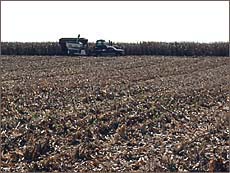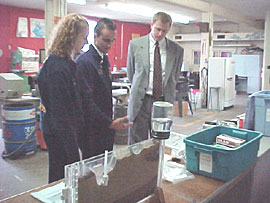|
Features,
Honors
& Awards, Ag
Announcements
Ag News Elsewhere
(fresh daily from the Web)
|
|
Features
|
|
Harvest
update
[OCT.
22, 2001] Harvest
is winding down in the Logan County area. We canít say it is
rapidly winding down, due to the weather not being very cooperative.
Estimates for harvest completed would be 95 percent for corn and 93
percent on soybeans. Yields have been better for later maturing
crops, due to the timing of pollination and seed set and available
moisture at critical times.
|
|
There
continue to be some wide swings in reported yields. Corn yields have
ranged from around 90 bushels to over 200, with most recently
harvested corn in the 160- to 180-bushel range. For soybeans, many
of the fields being recently harvested are in the 50- to 65-bushel
range.
It
seems like no matter how early we start harvest, Mother Nature doesnít
allow us to finish much before the last part of October or the first
of November.

Leasing
in central Illinois
One
of the topics that is always talked about, but less often addressed,
is farm leasing. Most of the talk centers on what cash rents are and
modifications to the traditional 50-50 crop share lease. In the
interest of focusing thoughts on leasing, following are some points
from a recent newsletter put out by Dale Lattz from the University
of Illinois.
Central
Illinois grain farms have about 14 percent of the land in the
operation owned by the operator; 65 percent of the land is rented on
a crop share basis; and 21 percent is rented on a cash lease basis.
Cash rented ground has increased about 1 percent a year for the last
five years at the expense of ground rented on shares.
Many
landlords and tenants are currently reviewing their lease
situations. There are advantages and disadvantages to any leasing
arrangement. From the landlordís perspective, there can be
significant impacts on how income is treated for self-employment tax
and how ground values are calculated for estate tax (if something
happens to you). Before making any changes, you should contact your
tax planner or attorney.
[to top of second column in this
article]
|
The
other thing that is considered at this time of year is the amount of
cash rent to charge. I donít know if there is such a thing as a
"fair" lease, but we should strive to have an equitable
lease. There is also no such thing as an "average" cash
rent. The range of cash rents in the county has over a $100-per-acre
spread. Each rental arrangement should be negotiated between parties
to fit their particular situation.
One
of the benchmarks to use in determining if cash rents should be
increasing or decreasing is equivalent cash rents. This is the
payment a landowner would have received under a traditional crop
share arrangement. The 10-year average for northern and central
Illinois on high productivity soils is $138.04. This includes $33.03
in landowner expenses, which would mainly be real estate taxes.
The
other main point to consider in establishing cash rental
arrangements is the government program payments. These payments are
shared according to risk. In a traditional 50-50 crop share
arrangement, this would be 50 percent to the landowner and 50
percent to the tenant. In a cash rent situation, the tenant would
get 100 percent of all payments. With a new farm bill being debated,
the future levels of payments are uncertain.
If
you want to check out the entire newsletter for yourself, visit the
site at http://www.farmdoc.uiuc.edu/manage/
newsletters/100901.html.
Good
luck in establishing your rental arrangements.
[John
Fulton]
|
|
|
Rep.
Wright visits Hartem ag program
[OCT.
16, 2001] Rep.
Jonathan Wright, R-Hartsburg, recently paid a visit to the
Hartsburg-Emden Agriculture Department. FFA members Natalie Coers
and Kent Leesman, along with agriculture teacher Betsy Pech, took
time to explain the agriculture education program, not only at
Hartsburg-Emden but statewide as well.
|
|
The
students informed Rep. Wright that Illinois agriculture
education has a line item in the Illinois State Board of
Education budget, which assists in funding high school
agriculture programs. This money also is used to develop new
curriculums, as well as developing agriculture literacy kits
for elementary students.
Kent
and Natalie gave Rep. Wright a tour of the agriculture
facilities, and he was able to see equipment, agri-science
kits and other supplemental supplies that the Hartsburg-Emden
agriculture program has purchased with the money appropriated
by the Illinois Legislature.
|

[Natalie Coers and Kent Leesman explain to Rep. Jonathan Wright the
purpose of the agri-science kits dealing with genetics, math in
agriculture and the many uses of dairy products.]
|
|
|
Nominations
needed for FSA election
[OCT.
9, 2001] Logan County Farm Service Agency is currently searching for
individuals representative of the county farmers to serve as
nominees for the county committee election, which this year is in
the district made up of Orvil, Prairie Creek, Broadwell, West
Lincoln, Corwin and Sheridan townships, according to FSA County
Executive Director Mark Fricke.
|
|
The Logan County FSA administers federal agricultural
production, farm loan, conservation and emergency programs
annually in Logan County. A locally elected committee of farmers
and landowners that serve staggered, three-year terms oversees
operation of the county office.
"It is critical to FSAís future that we ensure that all
farmers have an equal opportunity to be a candidate to serve as a
member on our county committees," said Fricke.
"Employees in the county office will be taking an active role
in contacting producers and farm groups, along with leaders of
minority, female and under-represented groups, to ensure that they
fully understand the role of the county committee."
Individuals of legal voting age with an interest in farmland as
an owner, operator, tenant or sharecropper or those who are eligible to
participate in any FSA program are eligible to vote in the
election and are eligible to serve on the committee if nominated
and elected. Spouses are also eligible to vote and serve on the
committee if nominated and elected.
[to top of second column in
this article]
|
"The
locally elected committees shoulder primary responsibility for
making national farm programs fit the needs and situations faced
by local farmers," Fricke said. "They bring local
expertise and knowledge to USDAís daily delivery of programs and
services."
Fricke
reminded farmers that for a nomination petition to be valid, it
must be limited to one nominee, must include written certification
that the nominee is willing to serve if elected and must be signed
by one eligible voter in the area holding the election this year.
Eligible voters may circulate or sign nomination petitions for as
many candidates as they choose.
The
deadline to return valid nomination petitions to the local FSA
office is Oct. 29.
Minority and female farmers are encouraged to take part in this
important nomination process. For more information, contact the
local FSA office or USDA service centers.
[News
release]
|
|
|
Nuisance
insect pests
[OCT.
6, 2001] With
fall definitely in the air, many of natureís own are trying to
find shelter for the winter. This group would include crickets,
ants, spiders, ladybugs and elm leaf beetles. They are really
seeking warmth, and they donít care if they are on a rock in the
sun or in your basement. Once in the home, you must decide whether
to use pesticides, the vacuum cleaner or tolerate them.
|
|
You
can save yourself a great deal of worry over the welfare of children
and pets by choosing a non-chemical course of action (the vacuum or
tolerance). Another option that keeps pesticides out of the house is
to spray a barrier of diazinon on the outside foundation of the
house.
Foundation
sprays can be reduced to following a five-step program to have good
success. Some of the insects and their relatives that can be
controlled or reduced would include ants, centipedes, cockroaches,
spiders and earwigs. In addition to trying for warmth, some of these
are just naturally hanging around in flower beds and lawns outside
the house.

Step
one is to purchase an emulsifiable concentrate of diazinon (liquid
form). Dilute with water to make a .5 percent solution for a
foundation spray. The average home requires about three gallons of
spray solution, so you will need about eight ounces of 25 percent
diazinon concentrate in three gallons of water to get the correct
percentage.
Step
two is to spray the foundation of the house just to the point of
runoff. Spray all the way around the house. Also make sure to spray
around the base of door openings.
[to top of second column in this
article]
|
Step
three is to also spray a 10- to 12-inch band of the solution on the
adjacent soil. A wider band may give better protection but also has
the extra insecticide involved. A wider band may be helpful if there
is a flower bed or shrubbery providing for more insects close to the
house.
Step
four is to spray behind concrete steps and other structures that
join up with the foundation. If you canít spray behind them, spray
over and around them.
Step
five is to spray cracks and crevices in the foundation and in
concrete slabs (such as driveways) that join the foundation.
The
idea is to crate a continuous barrier that insects, spiders,
millipedes and other pests have to crawl through to get into your
house. Even if they do get in, they wonít last long. Once insects
are in the home, you shouldnít use anything other than aerosol
products that are labeled for use in the home. Many of the products
just kill things that they come in contact with. A few do have a
lasting residual. Remember that the more residual pesticides have,
the more chances for accidentally causing poisoning problems.
Any
time that you are dealing with pesticides, you should read the
label. The label is a legal document that should tell what it
controls, how to mix, how to apply, safety precautions and other
important information.
Good
luck to you as we enter fall and try to keep those nuisance pests
out of your home.
[John
Fulton]
|
|
|
4-H
prepares for centennial in 2002
[OCT.
3, 2001] The
4-H centennial celebration will be in 2002. Itís not very often
that we get to celebrate 100 years, so there will be several special
events throughout the year. One of the main goals of the committee
at this time is to identify past 4-H members living in the Logan
County area.
If
you are a past 4-H member living in Logan County, please contact the
Extension office for a past member involvement form, so that we may
build a record of former members living in the area. The Centennial
Committee is considering several activities in the coming year that
would involve these former 4-Híers.
Please
contact us by e-mail at logan_co@mail.aces.uiuc.edu,
by paper mail at 980 N. Postville Drive, Lincoln, IL 62656 or by
phone at (217) 732-8289. If you are one of the past 4-H members from
Logan County who lives away from the area, we would also like to
hear from you!
[John
Fulton]
|
|
|
Honors
& Awards
|
|
|
|
|
Ag
Announcements
|
|
|
|